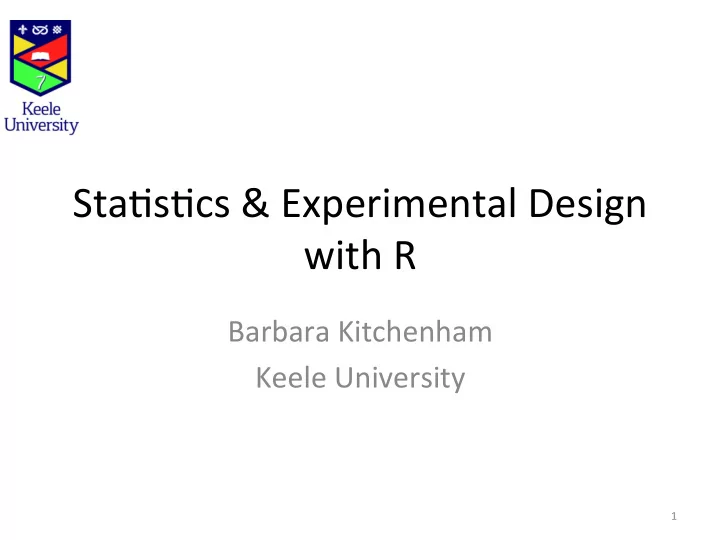

Sta$s$cs ¡& ¡Experimental ¡Design ¡ with ¡R ¡ Barbara ¡Kitchenham ¡ Keele ¡University ¡ 1 ¡
Propor$ons ¡and ¡Chi-‑squared ¡ 2 ¡
Comparing ¡ Independent ¡ Probabili$es ¡ • Address ¡ques$ons ¡such ¡as ¡ – Is ¡the ¡failure ¡rate ¡of ¡one ¡set ¡of ¡projects ¡greater ¡than ¡ failure ¡rate ¡of ¡another? ¡ • General ¡situa$on ¡ – We ¡have ¡one ¡set ¡of ¡N 1 ¡objects ¡of ¡which ¡X ¡have ¡a ¡ characteris$c ¡ – Another ¡independent ¡set ¡of ¡objects ¡N 2 ¡of ¡which ¡Y ¡ have ¡the ¡characteris$c ¡ – Is ¡p 1 =X/N 1 ¡significantly ¡greater ¡than ¡p 2 =Y/N 2 ¡ • There ¡is ¡an ¡exact ¡test ¡based ¡if ¡X ¡or ¡Y ¡are ¡small ¡ based ¡on ¡the ¡hyper ¡geometric ¡distribu$on ¡ – R ¡func$on ¡fisher.test ¡ 3 ¡
Large ¡Sample ¡Approxima$on ¡ Chi-‑Squared ¡test ¡of ¡Homogeneity ¡ Success ¡ Failures ¡ Totals ¡ Sample ¡1 ¡ O 11 ¡ O 12 ¡ n 1 . ¡ Sample ¡2 ¡ O 21 ¡ O 22 ¡ n 2 . ¡ Totals ¡ n. 1 ¡ n. 2 ¡ n.. ¡ 4 ¡
Example ¡ Success ¡ Failures ¡ Totals ¡ Sample ¡1 ¡ 4 ¡ 8 ¡ 12 ¡ Sample ¡2 ¡ 1 ¡ 20 ¡ 21 ¡ Totals ¡ 5 ¡ 33 ¡ 33 ¡ • R ¡has ¡the ¡prop.test ¡which ¡accepts ¡the ¡data ¡ directly ¡or ¡via ¡a ¡matrix ¡of ¡the ¡same ¡format ¡ – prop.test(x=c(4,1),n=c(12,21) ¡correct=F) ¡ • Chi-‑squared=4.849, ¡df=1. ¡p-‑value=0.0448 ¡ – prop.test(x=c(4,1),n=c(12,21) ¡correct=T) ¡ • Chi-‑squared=2.8812, ¡p-‑value=0.8962 ¡ • Fisher ¡test ¡has ¡p-‑value=0.0471 ¡ 5 ¡
Another ¡Classic ¡solu$on ¡ • Test ¡a ¡sta$s$c ¡of ¡the ¡form ¡ – (p 1 -‑p 2 )/(standard ¡error) ¡ – Where ¡the ¡standard ¡error ¡is ¡the ¡square ¡root ¡variance ¡of ¡average ¡ effect ¡i.e. ¡p ave =(X+Y)/(N1+N2) ¡ – This ¡type ¡of ¡test ¡is ¡called ¡a ¡Wald ¡test ¡ • From ¡Normal ¡approxima$on ¡ – Var( ¡p ave )=p ave (1-‑p ave )/(N1+N2) ¡ • Is ¡there ¡a ¡poten$al ¡problem? ¡ – If ¡H0 ¡is ¡true ¡p 1 ¡and ¡p 2 ¡are ¡both ¡es$mates ¡of ¡the ¡probability ¡ es$mated ¡by ¡ ¡p ave ¡ ¡ and ¡Var( ¡p ave ) ¡is ¡ ¡best ¡es$mate ¡of ¡common ¡ variance ¡ – If ¡H0 ¡is ¡false, ¡the ¡a ¡“common” ¡variance ¡may ¡be ¡misleading ¡ par$cularly ¡if ¡ ¡ • N1 ¡and ¡N2 ¡are ¡very ¡different ¡ ¡ 6 ¡
Alterna$ve ¡approach ¡ • MonteCarlo ¡simula$on ¡ – Simulate ¡two ¡independent ¡normal ¡variables ¡x ¡ and ¡y ¡ ¡ • M i =p i ¡and ¡Var=p i (1-‑p i )/N i ¡(i=1, ¡2) ¡ • 500 ¡of ¡each ¡ – Calculate ¡z=x-‑y ¡to ¡assess ¡the ¡distribu$on ¡of ¡ the ¡difference ¡between ¡the ¡two ¡parameters ¡ – Calculate ¡the ¡variance ¡of ¡z ¡ – Test ¡sta$s$c ¡= ¡(p 1 -‑p 2 )/sqrt(var(z)) ¡ 7 ¡
Example ¡ • Is ¡p1=4/12 ¡different ¡to ¡P2=1/21? ¡ • Using ¡classic ¡approach ¡ – p1=0.333, ¡p2=0.0476, ¡p ave =05/33=0.1515 ¡ – Var(p ave )=0.1515*(1-‑0.1515)/33=. ¡2.0704 ¡ – T=(0.3333-‑0.0476/sqrt(0.016796)=2.20 ¡ • Cri$cal-‑level ¡one-‑sided ¡=1.65 ¡(based ¡on ¡standard ¡ normal ¡distribu$on ¡ • Using ¡a ¡simula$on ¡approach ¡(based ¡on ¡a ¡ sample ¡of ¡500 ¡for ¡x ¡and ¡y) ¡ – Var(diff)=0.01988, ¡sd=.1410 ¡ – T=0.2854/0.1410=2.02 ¡ 8 ¡
Simula$on ¡results ¡ Histogram of z 140 120 100 Frequency 80 60 40 20 0 -0.2 0.0 0.2 0.4 0.6 0.8 z 9 ¡
Con$ngency ¡Tables ¡ • Items ¡in ¡a ¡popula$on ¡are ¡cross-‑classified ¡in ¡ two ¡dimensions ¡ – Are ¡the ¡characteris$cs ¡independent? ¡ • Confusion ¡Matrix ¡example ¡ – Is ¡a ¡predictor ¡algorithm ¡beler ¡at ¡iden$fying ¡ faulty ¡modules ¡than ¡chance? ¡ • Each ¡module ¡is ¡classified ¡according ¡to ¡its ¡true ¡status ¡ (faulty, ¡Not ¡faulty) ¡ • Also ¡classified ¡by ¡predictor ¡as ¡faulty ¡or ¡not ¡faulty ¡ • Are ¡the ¡correct ¡classifica$ons ¡beler ¡than ¡chance? ¡ – Also ¡used ¡for ¡predic$ng ¡failing ¡projects ¡ 10 ¡
Confusion ¡Matrix ¡ Module ¡ Module ¡Status ¡ predic$ons ¡ Faulty ¡ Not ¡ Totals ¡ Faulty ¡ Faulty ¡ O 11 ¡ O 12 ¡ n 1 . ¡ Not ¡Faulty ¡ O 21 ¡ O 22 ¡ n 2 . ¡ Totals ¡ n. 1 ¡ n. 2 ¡ N=n.. ¡ Let ¡ p ij =probability ¡of ¡falling ¡into ¡cell ¡i,j ¡ ¡ • p 11 =Prob(Predic$on ¡Faulty)×Prob(Module ¡is ¡faulty) ¡ • H0: ¡p ij =p i . ¡×p. j ¡ ¡ for ¡i,j ¡ • Chi-‑squared ¡approach ¡is ¡exactly ¡the ¡same ¡ • 11 ¡
SE ¡Issues ¡ • Being ¡beler ¡than ¡chance ¡at ¡predic$ng ¡is ¡a ¡ prely ¡weak ¡criterion ¡ – Would ¡like ¡to ¡assess ¡the ¡strength ¡of ¡the ¡ predic$on ¡model ¡ – Cramer ¡Coefficient ¡of ¡Associa$on ¡(Mathews) ¡ • C=sqrt(chi-‑squared/N) ¡ • Exactly ¡the ¡same ¡as ¡Pearson ¡correla$on ¡between ¡all ¡ the ¡individual ¡pairs ¡of ¡0 ¡and ¡1 ¡ – Would ¡like ¡to ¡assess ¡whether ¡one ¡model ¡is ¡beler ¡ than ¡another ¡ • Can ¡compare ¡the ¡C ¡values ¡ – Using ¡correla$on ¡equality ¡test ¡ 12 ¡
Hypothe$cal ¡Example ¡ ¡ Actual ¡ ¡ Es$mated ¡ Totals ¡ Failed ¡ Succeeded ¡ Failed ¡ 26 ¡ 15 ¡ 41 ¡ Succeeded ¡ 7 ¡ 37 ¡ 44 ¡ Totals ¡ 33 ¡ 52 ¡ 85 ¡ • Chi-‑squared=20.166 ¡ • df=1 ¡ • p=7.099e-‑06 ¡ • Correla$on=0.487 ¡ 13 ¡
Conclusions ¡ • Handling ¡propor$ons ¡is ¡rela$vely ¡straighqorward ¡ • Chi-‑squared ¡test ¡works ¡ – For ¡independent ¡propor$ons ¡ – Con$ngency ¡tables ¡ • Con$ngency ¡tables ¡ – Used ¡frequently ¡in ¡SE ¡to ¡evaluated ¡procedures ¡for ¡ iden$fying ¡failing ¡projects/components ¡ – Chi-‑squared ¡test ¡iden$fies ¡whether ¡predic$ons ¡beler ¡ than ¡chance ¡ – Correla$on ¡indicates ¡strength ¡of ¡associa$on ¡ 14 ¡
Recommend
More recommend